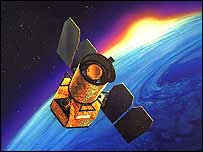GALEX (Galaxy Evolution Explorer)

GALEX (Galaxy Evolution Explorer) was an orbiting space telescope that observed galaxies in ultraviolet light across 10 billion years of cosmic history. The data it retured helped astronomers gain a better understanding of how galaxies evolve and change (see galaxy formation). Additionally, GALEX probed the causes of star formation during a period when most of the stars and elements we see today had their origins.
GALEX was equipped with a 50-centimeter telescope sensitive in the region 130–300 nanometers and an efficient spectroscope capable of obtaining the spectra of about 100,000 galaxies per year.
Led by the California Institute of Technology, GALEX conducted several first-of-a-kind sky surveys, including an extragalactic ultraviolet all-sky survey. It produced the first comprehensive map of a Universe of galaxies under construction, bringing us closer to understanding how galaxies like our own Milky Way were formed.
Other partners in the project included NASA, JPL (Jet Propulsion Laboratory), the Orbital Science Corporation, and various universities in California, France, and Japan. GALEX was the sixth SMEX (Small Explorer) mission.
The mission was extended three times over a period of 10 years before it was decommissioned in June 2013.
| launch date | Apr 28, 2003 |
| launch vehicle | Pegasus XL |
| launch site | Vandenberg Air Force Base |
| orbit | 694 × 700 km × 29.0° |
| mass | 280 kg |
Mission highlights
October 2003: Capture ofthe most sensitive and comprehensive image ever taken of the Andromeda Galexy.
April 2004: Observation of a giant stellar eruption, or flare, about one million times more energetic than those from the Sun.
December 2004: Observation of what appear to be massive "baby" galaxies in our part of the universe, suggesting our aging universe is still producing new galaxies.
August 2006: Observations indicating that supermassive black holes in some giant galaxies create such a hostile environment, they shut down the formation of new stars.
December 2006: Observations allowing scientists for the first time to see the process of a black hole eating a star.
November 2007: Observations proving the "nature" theory of galaxy evolution, which holds that galaxies are evolutionarily linked.
February 2009: Identification ofdwarf galaxies forming out of nothing more than pristine gas likely leftover from the early universe, rather than in association with dark matter or gas containing metals.
August 2010: Astronomers, using data from GALEXr, find that galaxies presumed "dead" and devoid of star-making can be reignited with star birth, and that galaxy evolution does not proceed straight from the cradle to the grave.
April 2011: Astronomers come up with a new way to identify planets beyond our solar system based on GALEX's use of tultraviolet imaging.
May 2011: GALEX and the Anglo-Australian Telescope complete a five-year survey of 200,000 galaxies stretching back seven billion years in cosmic time. The results lead to one of the best independent confirmations that dark energy is driving our universe apart at accelerating speeds.


